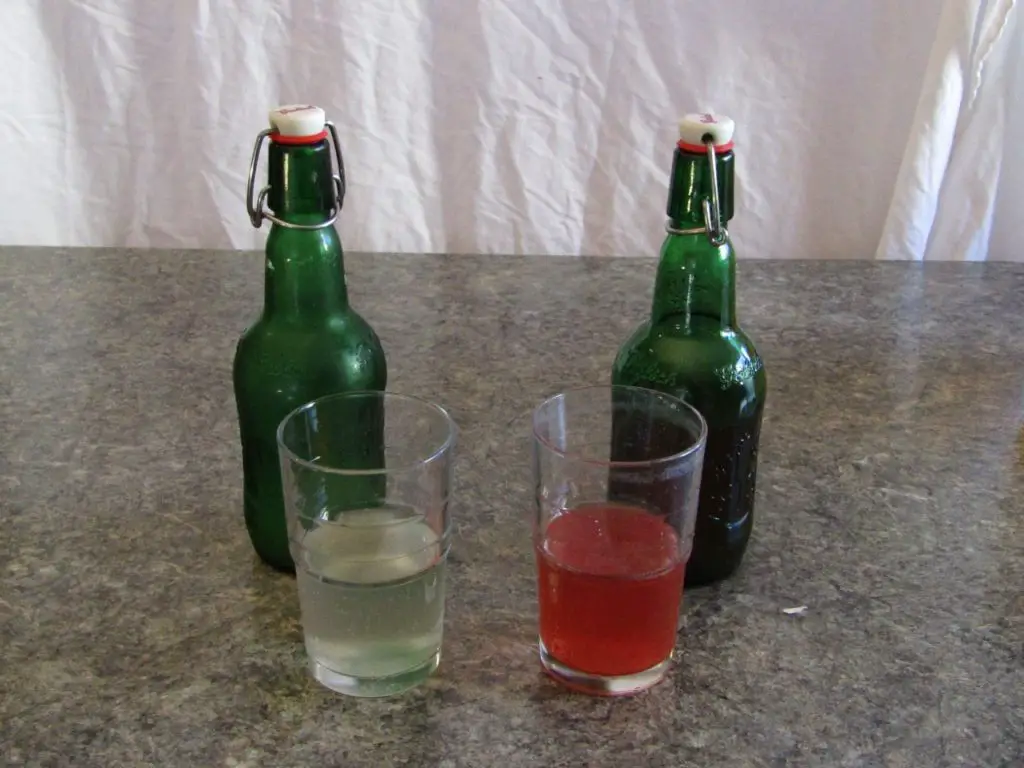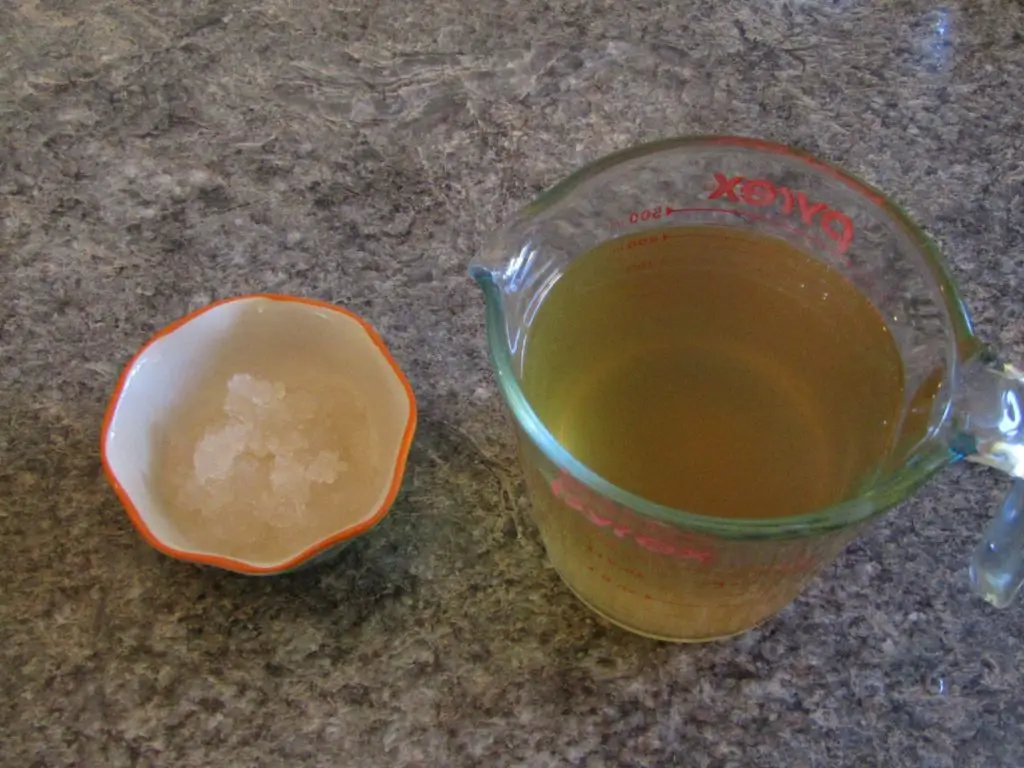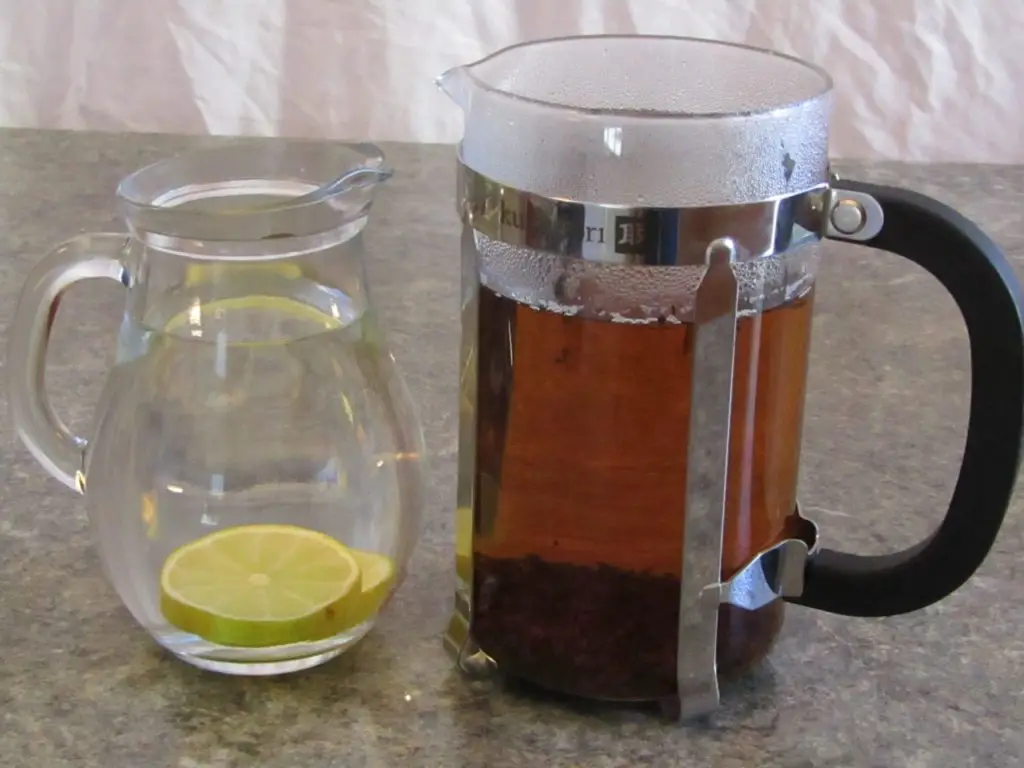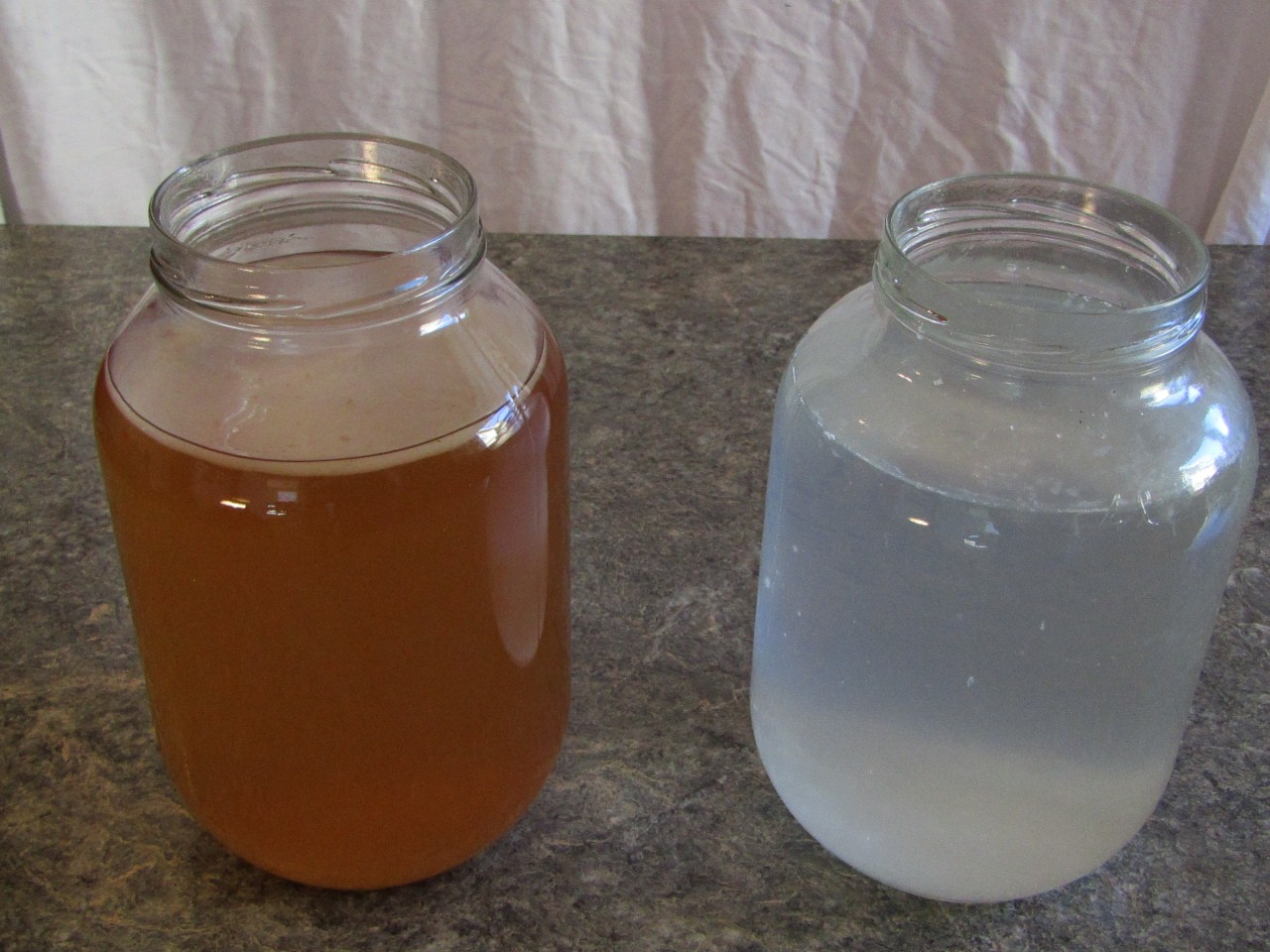This post contains affiliate links.
Kombucha and water kefir are both probiotic drinks which contain live bacteria cultures. They both can be made into a flavored carbonated drink with a variety of flavors. The similarities continue with the method of fermentation being aerobic meaning both require oxygen to culture properly. So why all the fuss about which is which?
Well as it turns out there are many differences between kombucha and water kefir which make the two very different drinks. It is like asking what the difference is between coffee and tea. Both contain caffeine, are made with hot water and both can be sweetened with milk and sugar but everyone knows that the two drinks are totally different.
Kombucha and Water Kefir Differences Chart |
||
|---|---|---|
Characteristic | Kombucha | Water Kefir |
Flavor |
||
| Fragrance |
|
|
| Taste |
|
|
| Mouthfeel |
|
|
Fermentation Methods |
||
| Physical Apperance |
|
|
| Time Period |
|
|
| Enoculation Method |
|
|
Fermentation Medium |
||
| Liquid Medium |
|
|
| Sugar Sources |
| |
Acid Content |
||
| Organic acid |
|
|
Kombucha and water kefir’s different flavor

Kombucha’s tangy flavor is made up of a wide variety of components (for an indepth look at the various components which make up kombucha’s flavor read this article here). Flavor is made up of three main components; Smell, Taste and Mouthfeel.
The difference between kombucha and water kefirs smell
The smell of something depends on the volatile (aromatic) components found in it. Volatile compounds quickly dissipate into the air making them detectable to our olfactory senses. Since both kombucha and water kefir are second fermented in a pressurized environment the aromatic compounds remain in suspension until the container is opened. When the pressure is released, the volatile compounds are released into the air with the carbon dioxide.
Kombucha’s smell stems mainly from the acetic acid compounds which are carried out with the carbon dioxide gas, this gives kombucha an acidic odor. The other predominant smell stems from the flavoring agent, anything from fruit to herbs, used in the second fermentation. Other volatile components in kombucha come from other volatile organic acids and polyphenols produced by the culture during fermentation.
Water kefir’s smell stems mainly from the second fermentation flavoring. It is much less acidic and with the normal shorter fermentation period produces less acetic acid, reducing its acidic smell.
The difference between kombucha and water kefir’s taste
Taste is defined as the sensations detected by the taste buds in the mouth. The taste buds are made up of five different types which detect different chemical compounds, they are:
- Sweet
- Salt
- Bitter
- Sour
- Umami
Everything you eat has a combination of these five tastes in different combinations and strengths which give each a unique taste. Kombucha and water kefir have little salt taste making no difference in its salty taste but the other four have major effects on the taste profile.
Difference in sweetness between kombucha and water kefir
The sweetness of kombucha is dependent on the amount of sweetener added at the brewing stage and second fermentation periods.
Most recipes call for a ratio of one cup of sugar to one gallon of tea to as much as 1 ½ cups of sugar per one gallon. Kombucha is sweetest during the early stages of fermentation and gets progressively less so as the acetic and lactic acid bacterial species found in the culture consumes the sugar. The relatively long fermentation time(7-14 days) lowers the available sugar producing organic acids in its place.
Water kefir is made with the same sugar to liquid ratio of one cup per gallon but the fermentation period is much shorter (2-5 days). This gives the culture less time to metabolize the sugar in the substrate and therefore produce a sweeter product.
Difference in bitterness between kombucha and water kefir
Kombucha is made with a strong tea infusion which contains a high amount of catechins, 70% or so are recognized by the taste buds as bitter compounds. The amount of catechins in the tea depends on what type of tea it is. White and green teas contain the highest amount of catechins whereas black and pura tea have lesser amounts. The presence of catechins produces the bitter taste which can be detected in kombucha.
Water kefir is usually made from a substrate which does not contain any catechins. This lowers the bitterness of water kefir to an undetectable amount in the finished drink. It can become bitter if it is second fermented in a bitter liquid such as a hop infusion or mint.
Difference in sourness between kombucha and water kefir
Kombucha’s taste is predominantly composed of sour components. The acetic acid bacteria which dominates the fermentation produces high amounts of acetic acid. Lactic acid bacteria also produce some lactic acid which has a smaller effect on the sour taste.
Water kefir is fermented for a drastically shorter time, depending on the ambient temperatures it could be as little as two days to as many as five. This gives the acetic acid bacteria substantially less time to consume the sugar in the liquid substrate (sweetened water, coconut water or fruit juice). This lowers the production of acetic acid making for a less sour product.
Difference in umami between kombucha and water kefir
For a long time umami was not considered a taste as scientists could not identify any taste buds which could detect it but it now is considered a detectable taste in the mouth. Taste buds which detect glutamates, although the most famous glutamate is monosodium glutamate there are several other types.
Glutamic acid is an amino acid which is found in various foods including tea leaves. As it ferments it will combine with whatever salts present in the tea. This makes for a complex umami flavor which boosts its flavor profile.
Water kefir can have some glutamic acid depending on the liquid the grains are added to. Most people use water with small amounts of natural sugar which have small amounts of glutamic acid. This results in little umami flavor in water kefir unless it is fermented over a longer period of time with a substrate containing high amounts of glutamic acid such as ginger, turmeric, cinnamon and spearmint.
Kombucha and water kefir’s different fermentation methods

On the surface the fermentation methods of kombucha and water kefir are basically the same. Add the starter to a sweetened liquid, place a permeable cover on the top of the container and wait the prescribed number of days but if you analyze each method you find they are drastically different.
Kombucha starts with a cooled tea infusion sweetened with some type of sugar. The tea is pasteurized automatically due to how it is made, the heating of water and infusion with the leaves, and the sugar is liquified and undergoes some chemical transformation from the beginning of the fermentation. Once cooled the tea is infused with a SCOBY (symbiotic culture of bacteria and yeast) in a method of fermentation called backslopping.
Backslopping is the use of some of the liquid from a previous batch of a finished fermentation as a starter for the next. The floating cellulose mat is often added to the sweet tea but is unnecessary for fermentation to happen.
Water kefir on the other hand is made by the addition of water kefir grains to a sweetened liquid. The grains are the source of the fermentation bacteria and are very protective of the bacteria which are allowed residency in the grains. The liquid is not heated usually prior to the addition of the grains so there will be transient bacteria in the water kefir which can affect the flavor.
Kombucha and water kefir’s different liquid medium

Kombucha is made from sweet tea infusions. Tea which comes from the leaves of the camilia sensus plant. This means that they contain caffeine and other organic compounds found in the tea leaves. Tea is high in polyphenols which provide the tea with its flavor. They color the water, provide bitterness and transfer some of the aromatic compounds to the hot water.
Water kefir is made from filtered water, coconut water or occasionally fruit juice. The water is sweetened with any type of sugar including cane, brown, raw or beet. Molasses can also be added in small amounts to add minerals to the water to help the grains to grow.
Kombucha and water kefir’s different culture’s physical makeup
Most people are confused about the culture which is used to make kombucha, believing that it is the cellulose mat (called a pecile) which harbors the bacteria and yeast for the fermentation to begin but in reality the culture or SCOBY is in the liquid reserved for the next batch. It is true that the pecile does harbor the same culture as the liquid reserved from the last batch but it makes for a poor starter.
Kombucha’s starter culture comes from the backslopping method of fermentation. Inoculating the sweet tea with the liquid starter culture in at least a 1:10 ratio.
The kombucha starter culture can also be made from scratch. It is a collection of bacteria and yeasts which are found worldwide. Just like sourdough it can be started from sweet tea and time. For instructions on how to do so check out this article here. Every kombucha culture is different depending on its heritage, current location and past and present substrate (the various types of tea used).
Water kefir’s culture is found in and around the kefir grains. They are small transparent cellulose “grains” which house the kefir’s bacterial culture. They can multiply increasing in number when they are fed correctly and will perpetually make new batches of kefir as long as they are cared for.
Although water kefir can be made a few times using the backslopping method (using some of the finished water kefir for the next batch) it will only work a few times successfully.
Water kefir grains cannot be made. It is not known what combination of bacteria and yeasts produce the unique grain-like structure of water kefir. They were discovered growing in cactus plants in Mexico where they are known as tibicos.
Kombucha and water kefir’s different fermentation time
The recommended fermentation time for kombucha is 7-14 days but there have been studies around the health benefits of kombucha as it ages which indicate that kombucha which has fermented for 60 days has highly beneficial effects. Since most people drink kombucha for more than health benefits it is usually consumed while there is some unfermented sugar left in the liquid and the pH is still above 3.0.
Water kefir has a substantially shorter fermentation time, anywhere from 2-5 days depending on how sweet you want it, the ambient temperature and how many grains were used. Since none of these are controllable with accuracy at home you will have to test it regularly as it ferments.
If water kefir grains are left in the same water long enough the culture will run out of food and die. The grains will dissolve and produce a sludge on the bottom of the jar. To take a break from making water kefir for longer than a month the grains should be dehydrated and stored in a cool dry location.
Kombucha and water kefir’s different organic acids content
Kombucha
The organic acids in kombucha stem from the tea leaves used and bacterial action. Although not all of the following acids are present in all kombucha samples a high majority of them appear in studied samples.
- Glucuronic
- Gluconic
- Lactic
- Malic
- Citric
- Tartaric
- Folic
- Malonic
- Oxalic
- Succinic
- Pyruvic
- Usnic
Water kefir
- Lactic
- Acetic

